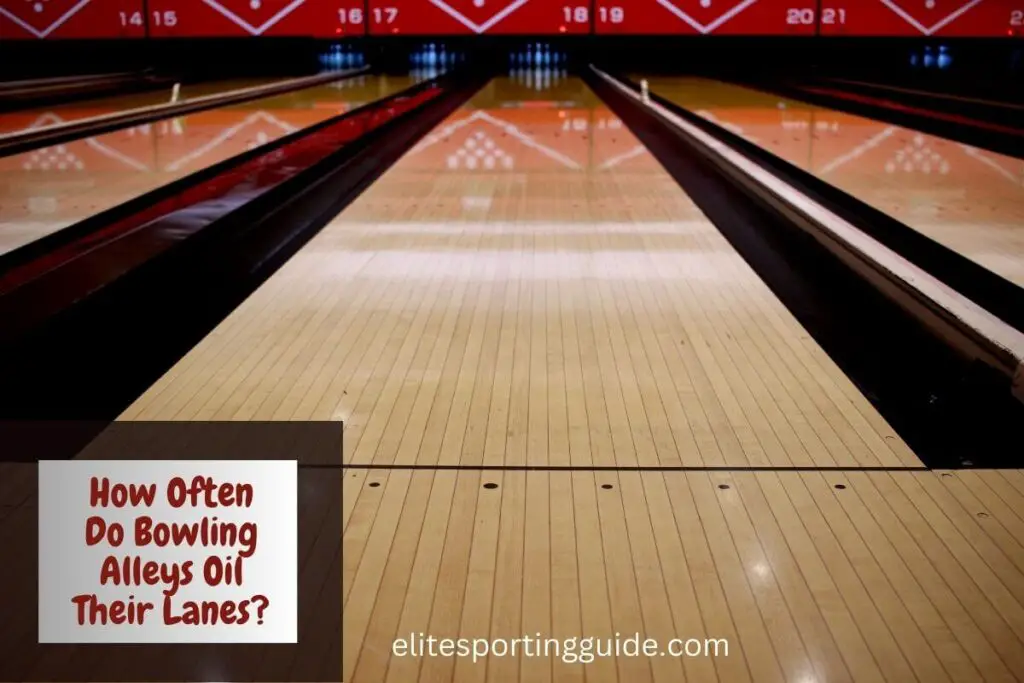Maintaining optimal lane conditions is necessary for a satisfying bowling experience and one key aspect of this maintenance is the regular application of oil to the lanes.
The frequency at which bowling alleys oil their lanes can significantly impact the game’s difficulty and overall performance.
In this article, we answer the question that frequently arises among bowling enthusiasts: how often do bowling alleys oil their lanes?
By listing various factors that influence oiling frequency, such as lane usage patterns and desired lane conditions, we aim bring attention to the practices and considerations behind this essential aspect of the sport.
How Often Do Bowling Alleys Oil There Lanes?
Generally, it is common for bowling alleys to oil their lanes anywhere from once a day to once a week. Bowling alleys typically oil their lanes on a regular basis, with the frequency varying depending on factors such as lane usage and lane conditions desired.
Importance of Lane Maintenance
Lane maintenance is of utmost importance to ensure a high-quality and fair bowling experience.
Proper lane maintenance helps to maintain consistent lane conditions, creating a level playing field where skill and technique are the primary factors influencing performance.
By regularly cleaning and oiling the lanes, bowling alleys can provide a consistent ball reaction and predictable lane play, allowing bowlers to showcase their abilities and compete on an even playing field.
Furthermore, lane maintenance is essential for protecting the integrity and longevity of the lanes.
Regular cleaning helps to remove dirt, debris, and oil buildup, preventing lane damage and preserving the surface for extended use.
Oiling the lanes correctly reduces friction and wear on the surface, preventing warping, cracking, or other forms of deterioration.
By prioritizing lane maintenance, bowling alleys can ensure the longevity of their lanes, reduce repair and replacement costs, and provide a positive experience for bowlers of all skill levels.
Factors Affecting Oiling Frequency
1. Lane Usage: The frequency of oiling lanes depends on how frequently and intensely they are used. High-traffic bowling alleys may require more frequent oiling compared to those with lower usage.
2. Lane Conditions: Desired lane conditions, such as oil pattern length and volume, also play a role in determining the oiling frequency. Different patterns require specific maintenance schedules to ensure consistent gameplay.
3. Climate and Humidity: Environmental factors, including climate and humidity levels, can affect the lane surface and the oil’s longevity.
Alleys in humid regions may need more frequent oiling to counteract the moisture’s impact.
4. Bowling Ball Types: The type of bowling balls used can influence the oiling frequency. Reactive resin balls absorb oil, which can lead to changes in lane conditions, requiring more frequent oiling to maintain consistency.
5. Bowler Preferences: Some bowlers prefer different lane conditions, such as dryer or oilier surfaces. The oiling frequency can be adjusted based on bowler feedback and preferences to accommodate their playing styles.
6. Budget and Resources: Oiling lanes requires time, effort, and resources. The frequency of oiling may be influenced by the available budget and staffing resources of the bowling alley.
7. Maintenance Equipment: The availability and effectiveness of maintenance equipment, such as lane machines, can impact the oiling frequency. Efficient machines can streamline the process and allow for more frequent maintenance.
8. Competition Schedule: Bowling alleys hosting professional or league competitions may have specific guidelines and schedules for oiling lanes, ensuring fair and consistent play. These schedules may differ from regular maintenance routines.
9. Lane Surface Condition: The condition of the lane surface, including its age, wear, and tear, can affect how frequently lanes need to be oiled. Worn-out surfaces may require more frequent oiling to maintain desired playing conditions.
Lane Usage Patterns and Oiling Practices
Lane maintenance plays a vital role in the overall bowling experience and the sport’s integrity. Here are some key reasons highlighting the importance of lane maintenance:
1. Consistent Gameplay: Regular lane maintenance, including oiling, ensures consistent lane conditions for bowlers.
It creates a level playing field where skill and technique are the primary factors, allowing fair competition and reliable performance measurement.
2. Lane Protection: Proper maintenance helps protect the lane surface from excessive wear and damage caused by bowling balls.
Oiling provides a protective barrier that reduces friction between the ball and the lane, minimizing the impact on the lane surface. This helps prevent scratches, gouges, and other forms of surface damage that can affect the ball’s trajectory and bowlers’ ability to make accurate shots.
By maintaining the integrity of the lanes, bowlers can enjoy a smoother and more reliable ball roll, enhancing their overall experience.
3. Player Safety: Lane maintenance is essential for ensuring the safety of bowlers. Regular cleaning and maintenance practices help remove debris, dirt, and other foreign objects from the lanes that could cause slips, falls, or disruptions during play.
Additionally, proper oiling reduces the risk of excessive lane friction, which can result in ball hooks, unexpected ball reactions, and potential injuries.
By keeping the lanes in good condition, bowling alleys create a safer environment for bowlers of all skill levels, promoting their enjoyment of the game without compromising their well-being.
Lane maintenance is imperative for maintaining the quality, fairness, and safety of the bowling experience.
By prioritizing regular cleaning, oiling, and maintenance practices, bowling alleys can ensure consistent gameplay, protect the lanes from damage, and provide a safe environment for bowlers.
Whether for recreational or competitive purposes, a well-maintained lane contributes to the overall enjoyment and success of the sport, fostering a positive and rewarding experience for bowlers of all ages and skill levels.
Desired Lane Conditions and Oiling Strategies
Desired lane conditions and effective oiling strategies go hand in hand to create an optimal bowling experience. Here are some key aspects to consider:
1. Oil Pattern Length: The length of the oil pattern refers to how far the oil is applied on the lane. Short oil patterns, typically up to 32 feet, result in less ball skid and an earlier hook.
Long oil patterns, usually beyond 40 feet, provide more skid and a delayed hook. Determining the desired oil pattern length depends on factors such as bowler skill level, ball reaction preferences, and lane conditions.
2. Oil Pattern Volume: The volume of oil applied to the lanes affects ball movement and lane transition. Higher oil volume leads to more oil in the front part of the lane, resulting in increased skid and later hook.
Lower oil volume creates less skid and an earlier hook. Balancing the oil pattern volume is key to achieving the desired lane conditions, considering factors like lane topography, ball characteristics, and bowler abilities.
3. Lane Topography and Oiling Machine Adjustments: Lane topography, including variations in slope and unevenness, influences oil distribution.
Oiling machines can be adjusted to compensate for these irregularities, ensuring a more consistent oil pattern across the lane.
By analyzing the topography and making appropriate adjustments, bowling alleys can create uniform lane conditions and mitigate potential biases.
4. Oiling Patterns for Different Playing Styles: Different playing styles require specific oiling strategies. For bowlers with higher ball speeds and more direct angles, a flatter oil pattern may be suitable.
Bowlers with lower ball speeds or more angular shots may benefit from a pattern with a defined shape. Oiling patterns can be customized to accommodate various playing styles, enhancing the bowlers’ ability to perform at their best.
5. Lane Maintenance Schedule: Establishing a regular lane maintenance schedule is essential for consistent oiling practices.
This includes determining the frequency of oiling, cleaning, and reapplying oil to maintain the desired lane conditions.
The schedule should consider factors such as lane usage, foot traffic, and climate conditions to ensure optimal performance.
In summary, desired lane conditions and effective oiling strategies involve considerations such as oil pattern length, volume, lane topography, playing styles, and a well-planned maintenance schedule.
By understanding these factors and implementing appropriate oiling techniques, bowling alleys can create an environment that suits the preferences and needs of bowlers, promoting fair play and an enjoyable bowling experience for all.
Professional Bowling Competitions and Oiling Protocols

Professional bowling competitions follow specific oiling protocols to ensure fair play and a challenging yet consistent environment for competitors. Here are two key aspects of oiling protocols in professional bowling:
1. Oil Pattern Selection: Professional bowling events use carefully selected oil patterns to provide a balance of challenge and fairness. Different oil patterns have varying lengths, volumes, and shapes, which significantly impact ball motion and lane playability.
The chosen oil patterns are often classified as “house patterns” or “sport patterns.” House patterns are typically designed to allow for higher scoring and more forgiving play, while sport patterns are more challenging and require greater precision and skill.
The selection of the oil pattern depends on the desired difficulty level and the objective of the competition.
2. Oiling Patterns and Application: The oiling process itself is meticulously executed to achieve the desired lane conditions.
Oiling patterns are carefully chosen based on factors such as lane topography, lane surface characteristics, and the expected behavior of different bowling balls.
The oil is then applied using computerized lane machines to ensure uniformity and accuracy.
The application process considers parameters such as oil volume, distribution, and specific instructions from the event organizers, the goal is to create consistent playing conditions across all lanes, minimizing lane-to-lane variations and providing a fair playing field for all competitors.
It’s important to note that the specific oiling protocols may vary between different professional bowling competitions and organizations.
Each event may have its unique guidelines and specifications regarding oil patterns and application processes to suit the competition’s objectives and the desired level of challenge.
These protocols aim to provide a fair and competitive environment, where bowlers’ skills and adaptability are put to the test, contributing to exciting and engaging professional bowling competitions.
Common Oiling Schedules in Bowling Alleys
Common oiling schedules in bowling alleys can vary depending on factors such as lane usage, facility size, and available resources. However, here are three general categories of oiling schedules that are commonly followed:
1. Daily Oiling: Some high-traffic bowling alleys opt for daily oiling to maintain consistent lane conditions. Daily oiling ensures that the lanes are fresh and ready for optimal play each day.
This schedule is often employed in busy bowling centers where a significant number of games are played throughout the day.
2. Twice-Weekly Oiling: Many bowling alleys follow a twice-weekly oiling schedule. This involves oiling the lanes twice a week to maintain a good balance between lane conditions and maintenance efforts.
This schedule is commonly seen in facilities that experience moderate to high lane usage, such as bowling centers with league play and regular customer traffic.
3.Weekly Oiling: Bowling alleys with lower lane usage may choose to oil their lanes once a week. This schedule is often implemented in smaller bowling centers or those with less frequent play.
Weekly oiling allows for sufficient lane conditioning while minimizing maintenance requirements.
It’s important to note that these schedules can vary based on specific factors unique to each bowling alley, including the type of oil used, climate conditions, and customer preferences.
Bowling alleys may also adjust their oiling schedules during special events or tournaments to cater to specific playing conditions or player requirements.
Impact of Oiling Frequency on Bowling Performance
The frequency of oiling in bowling alleys has a significant impact on bowling performance. Here are two key aspects to consider:
1. Lane Transition: The rate at which the oil pattern on the lane changes is directly influenced by the frequency of oiling. When lanes are freshly oiled, bowlers can expect consistent ball reaction and predictable results.
As the oil pattern begins to break down and transition, the lane conditions change, requiring bowlers to adjust their strategy and ball selection.
Frequent oiling can result in more frequent lane transitions, challenging bowlers to adapt their shot-making techniques and equipment choices more frequently throughout a game or session.
2. Ball Motion and Hook Potential: The frequency of oiling also affects ball motion and hook potential. Freshly oiled lanes typically provide more oil on the surface, creating greater skid and limiting the ball’s ability to hook
As the oil pattern breaks down over time, the lane surface becomes drier, allowing the ball to grip the lane and generate more hook potential.
Bowlers who prefer a stronger hook or greater backend motion may benefit from lanes that have gone through some degree of transition.
However, excessive lane breakdown due to infrequent oiling can result in inconsistent ball reaction and unpredictable results, making it challenging for bowlers to maintain a consistent performance.
Overall, finding the right balance in oiling frequency is necessary for optimal bowling performance. Regular oiling maintains more consistent lane conditions and helps manage lane transition effectively.
It allows bowlers to make more accurate and informed adjustments, adapt their game plan accordingly, and achieve better shot-making consistency.
On the other hand, infrequent oiling can lead to significant lane breakdown, making it more difficult for bowlers to maintain consistent ball reaction and achieve their desired performance levels.
Post you may be interested in: Are Bowling Balls Heavy?
Maintenance Techniques Beyond Oiling
Lane maintenance technology has made significant strides in enhancing the quality and consistency of bowling experiences.
These innovations have streamlined the lane maintenance process and improved overall performance.
Here are three notable advancements in lane maintenance technology:
1. Computerized Lane Machines: Traditional manual oiling methods have been replaced by computerized lane machines that offer precise and uniform oil application.
These machines utilize sensors and advanced programming to measure and distribute oil accurately across the lane surface.
The ability to customize oil patterns and adjust parameters such as length and volume allows bowling alleys to achieve specific lane conditions tailored to their needs.
2. Oil Pattern Design Software: Oil pattern design software has revolutionized the way bowling alleys create and fine-tune oil patterns.
Technicians can utilize data analytics and simulation algorithms to experiment with different pattern designs and evaluate their effects on ball motion and lane conditions.
This software empowers bowling alleys to optimize oiling strategies based on factors like skill levels, playing styles, and specific event requirements, leading to improved consistency and fairness in gameplay.
3. Lane Surface Analysis Tools: Advanced tools such as laser-based topography scanners have been developed to analyze lane surfaces and identify irregularities or areas that require attention.
By assessing lane topography and detecting issues like flat spots or excessive wear, bowling alleys can proactively address maintenance needs.
These tools enable better maintenance planning and help create a more uniform and predictable playing surface, enhancing the overall bowling experience.
Lane maintenance technology has brought about significant improvements in the bowling industry. Computerized lane machines, oil pattern design software, and lane surface analysis tools have transformed the way lanes are maintained.
These advancements have resulted in more consistent lane conditions, enhanced customization, and better overall performance, providing bowlers with a superior and more enjoyable bowling experience.
Related post: What Are Bowling Lanes Made Of?
Innovations in Lane Maintenance Technology
Innovations in lane maintenance technology have transformed the way bowling alleys care for their lanes, bringing advancements in accuracy and efficiency.
One notable innovation is the development of computerized lane machines. These machines use advanced sensors and programming capabilities to precisely measure and distribute oil across the lane surface, ensuring uniform and consistent lane conditions.
This automation eliminates human error and allows for customizable oil patterns, catering to different skill levels and event requirements.
Another significant innovation is the use of advanced lane surface analysis tools.
Laser-based topography scanners and imaging technology have emerged to assess the lane surface characteristics, detect irregularities, and identify maintenance needs.
These tools provide detailed measurements of the lane topography, helping bowling alleys proactively address issues like flat spots or excessive wear.
By analyzing the data obtained from these tools, bowling alleys can make informed decisions about maintenance and ensure a more even and predictable playing surface, enhancing the overall bowling experience.
These innovations in lane maintenance technology have revolutionized the industry, improving the accuracy, efficiency, and customization of lane maintenance processes.
Tips for Bowlers to Adapt to Different Oiling Patterns
Adapting to different oiling patterns is a significant skill for bowlers to excel in varying lane conditions. Here are two tips to help bowlers adjust effectively:
1. Observe and Read the Lanes: Pay close attention to how the ball reacts on the lane during warm-up or practice shots. Observe the length and shape of the oil pattern, as well as the ball’s motion and the breakpoint.
This information will give you valuable insights into how the oil is affecting your shot. By reading the lane, you can make informed decisions about where to target and how to adjust your line and equipment accordingly.
2. Modify Your Technique: Different oiling patterns require adjustments in your bowling technique
If the oil pattern is heavy and the ball doesn’t hook as much, you may need to increase your ball speed and play a more direct line to avoid the oil in the middle of the lane.
On the other hand, if the oil pattern is light or there is more friction on the outside, you may need to slow down your ball speed and open up your angle to allow the ball to hook into the pocket.
Adapting your release, ball speed, and angle of entry based on the oiling pattern will help you find the right line and maximize your scoring potential.
By observing and reading the lanes and making appropriate modifications to your technique, you can effectively adapt to different oiling patterns.
It’s important to practice and experiment during warm-up sessions to gain a better understanding of how the oil pattern affects your ball motion.
With experience and adaptability, you can confidently navigate various lane conditions and optimize your performance as a bowler.



